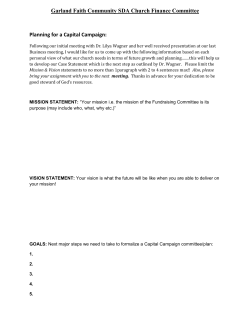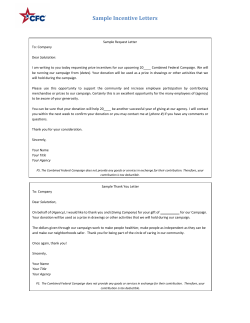
global_memo - GONSSO - Yale
Global Jupiter Observing Campaign Franklin Marsh (fmm02013@mymail.pomona.edu) and Bryan Penprase (bpenprase@pomona.edu) April 12, 2015 1 Introduction Thank you for your participating in our Global Jupiter Campaign - which is an outgrowth of our ICCP9 conference in Singapore during January 2016. The observational data from this campaign will be very important for helping us test the technology for coordinated international observing, and will also be useful as we prepare for our support observing during 2016 for the NASA Juno Mission. This memo, written by Pomona College’s Franklin Marsh and edited by Bryan Penprase, includes a simple outline of the 3 easy steps for gathering and staging data to participate in this first campaign of our Global Observatory Network for Solar System Observations. We will also place updates to our campaign, as well as a copy of this document on our web site at http://gonsso.commons.yale-nus.edu.sg. 1 2 Sign Up The first global observing campaign will take place from April 13 to April 17 (GMT). This time period time will be divided into two 2 day time slots. To participate in the campaign, simply capture video imagery of Jupiter once during both of the time slots, and upload the video files to the data repository. If you are planning on participating in the campaign, send an email to both Bryan Penprase and Franklin Marsh at the email addresses below: fmm02013@mymail.pomona.edu and bpenprase@pomona.edu confirming your interest. 3 Data Capture Each observatory will have different cameras and telescopes, some of which have been outlined in our Google Form. If you have not done so yet - please take a moment to describe the instrument and telescope you are using at our Google Form which is located at http://goo.gl/forms/f3ykRCFypZ. For optimal focus and image quality - please try to use the maximum magnification possible, and a narrow-band or broad-band filter will help with the sharpness of the image. The only definite requirement for the video data is that they are captured in .avi format, so a wide range of cameras and instruments should be usable for our campaign. Simply acquire and focus Jupiter using a video imager, and take 1 minute of data at the highest feasible framerate. If you are using a filter in front of the camera, note the filter used. Record the time that each video was captured, or better yet, record it into the filename. If you have any questions about the process of video imaging, let us know. Both Franklin and Bryan can help out with emails to our addresses above. This presentation by Christopher Go (hosted on the JUNO website) is a fantastic resource for those interested in learning more about planetary imaging: http://missionjuno.swri.edu/pub/e/downloads/Presentation By Christopher Go.pdf 2 4 File Upload To upload data, you have two choices. One is to email us a link to the files as they exist on Drop Box. The other would be to upload the .avi files to the google drive within the account known as observe.jupiter@gmail.com. We will be delighted to share the password for the account, and we will be posting the reduced data as well to this site. Please email us for that password. In either case we would like to request that you use a definite file naming protocol. Data files must be named according to the following scheme: jYYYY-MM-DD filter observer.avi Where “j” indicates the target Jupiter, the date is in year, month, day, format, and the filter codes are r,g,b for Red, Green, and Blue, and ch4 for the 890nm methane band. 5 Conclusion After the campaign, our team at Pomona College and Yale-NUS College will post process all of the raw videos and produce images and maps, that I will provide to Glenn Orton for evaluation and feedback. Hopefully, this short test run will allow us to work on improving collaboration between the observatories, and give us a flavor for what kind of data the telescopes on the network can produce. 3
© Copyright 2025











